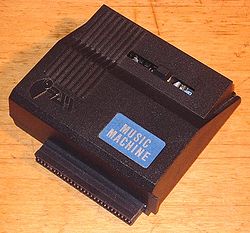Difference between revisions of "Music Machine"
(→completed manual upload) |
|||
| Line 5: | Line 5: | ||
The Amstrad CPC version was almost identical to the the ZX Spectrum version, only difference was the address decoding logic. | The Amstrad CPC version was almost identical to the the ZX Spectrum version, only difference was the address decoding logic. | ||
| + | |||
| + | == Technical Specifications == | ||
| + | |||
| + | Information from the manual: | ||
| + | |||
| + | The Music Machine incoporates two Ferenti devices for digital-to-analogue (DAC) and analogue-tod-digital (A to D) conversion. | ||
| + | The part numbers are ZN429E8 and ZN449 respectively. The circuit also include a Motorola 6850 ACIA (Asynchronous Communications Interface Adapter) for handling the MIDI channel, two anti-alias filters (one for input and one for output), a discrete microphone amplifier and a headphone amplifier. The clock signal for the ACIA and the ZN449 is provided by a ceramic oscillator. | ||
| + | |||
| + | The incomming signalo from the microphone amplifier is sampled to an 8-bit resolution at a rate of 19.444 thoudsand samples per second. This yields an analogue bandwidth of approximately 9.5KHz which is in fact the cutoff frequency of the filters. | ||
| + | |||
| + | All of the devices on The Music Machine data bus are accessible to the Amstrad within its IO space. ACIA transactions must use 16-bit IO instructions; the converters are accesible via 8-bit IO instructions. | ||
== Weblinks == | == Weblinks == | ||
| Line 35: | Line 46: | ||
Image:p24-25.jpg|Page 24-25 | Image:p24-25.jpg|Page 24-25 | ||
Image:p26-27.jpg|Page 26-27 | Image:p26-27.jpg|Page 26-27 | ||
| + | Image:p28-29.jpg|Page 28-29 | ||
| + | Image:p30-31.jpg|Page 30-31 | ||
| + | Image:p32-33.jpg|Page 32-33 | ||
| + | Image:p34-35.jpg|Page 34-35 | ||
| + | Image:p36-37.jpg|Page 36-37 | ||
</gallery> | </gallery> | ||
Revision as of 18:52, 28 August 2006
A digitally sound sampling and playback device. The Music Machine was built by a British Company called Ram Electronics.
The Amstrad CPC version was almost identical to the the ZX Spectrum version, only difference was the address decoding logic.
Technical Specifications
Information from the manual:
The Music Machine incoporates two Ferenti devices for digital-to-analogue (DAC) and analogue-tod-digital (A to D) conversion. The part numbers are ZN429E8 and ZN449 respectively. The circuit also include a Motorola 6850 ACIA (Asynchronous Communications Interface Adapter) for handling the MIDI channel, two anti-alias filters (one for input and one for output), a discrete microphone amplifier and a headphone amplifier. The clock signal for the ACIA and the ZN449 is provided by a ceramic oscillator.
The incomming signalo from the microphone amplifier is sampled to an 8-bit resolution at a rate of 19.444 thoudsand samples per second. This yields an analogue bandwidth of approximately 9.5KHz which is in fact the cutoff frequency of the filters.
All of the devices on The Music Machine data bus are accessible to the Amstrad within its IO space. ACIA transactions must use 16-bit IO instructions; the converters are accesible via 8-bit IO instructions.
Weblinks
Spanish site about the Music Machine
Manual
- Ram Music Machine Manual





















